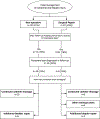Current Management of Extraperitoneal Bladder Injuries: Results from the Multi-Institutional Genito-Urinary Trauma Study (MiGUTS)
- PMID: 32259467
- PMCID: PMC8717861
- DOI: 10.1097/JU.0000000000001075
Current Management of Extraperitoneal Bladder Injuries: Results from the Multi-Institutional Genito-Urinary Trauma Study (MiGUTS)
Abstract
Purpose: We studied the current management trends for extraperitoneal bladder injuries and evaluated the use of operative repair versus catheter drainage, and the associated complications with each approach.
Materials and methods: We prospectively collected data on bladder trauma from 20 level 1 trauma centers across the United States from 2013 to 2018. We excluded patients with intraperitoneal bladder injury and those who died within 24 hours of hospital arrival. We separated patients with extraperitoneal bladder injuries into 2 groups (catheter drainage vs operative repair) based on their initial management within the first 4 days and compared the rates of bladder injury related complications among them. Regression analyses were used to identify potential predictors of complications.
Results: From 323 bladder injuries we included 157 patients with extraperitoneal bladder injuries. Concomitant injuries occurred in 139 (88%) patients with pelvic fracture seen in 79%. Sixty-seven patients (43%) initially underwent operative repair for their extraperitoneal bladder injuries. The 3 most common reasons for operative repair were severity of injury or bladder neck injury (40%), injury found during laparotomy (39%) and concern for pelvic hardware contamination (28%). Significant complications were identified in 23% and 19% of the catheter drainage and operative repair groups, respectively (p=0.55). The only statistically significant predictor for complications was bladder neck or urethral injury (RR 2.69, 95% 1.21-5.97, p=0.01).
Conclusions: In this large multi-institutional cohort, 43% of patients underwent surgical repair for initial management of extraperitoneal bladder injuries. We found no significant difference in complications between the initial management strategies of catheter drainage and operative repair. The most significant predictor for complications was concomitant urethral or bladder neck injury.
Keywords: epidemiology; multicenter study; trauma centers; urinary bladder; wounds and injuries.
Conflict of interest statement
Figures
Comment in
-
Editorial Comment.J Urol. 2020 Sep;204(3):544. doi: 10.1097/JU.0000000000001075.01. Epub 2020 Jun 23. J Urol. 2020. PMID: 32574510 No abstract available.
-
Editorial Comment.J Urol. 2020 Sep;204(3):544. doi: 10.1097/JU.0000000000001075.02. Epub 2020 Jun 23. J Urol. 2020. PMID: 32574511 No abstract available.
References
-
- Bjurlin MA, Fantus RJ, Mellett MM et al.: Genitourinary injuries in pelvic fracture morbidity and mortality using the National Trauma Data Bank. J Trauma, 67: 1033, 2009 - PubMed
-
- Johnsen NV, Dmochowski RR, Young JB et al.: Epidemiology of Blunt Lower Urinary Tract Trauma With and Without Pelvic Fracture. Urology, 102: 234, 2017 - PubMed
-
- Deibert CM, Spencer BA: The association between operative repair of bladder injury and improved survival: results from the National Trauma Data Bank. J Urol, 186: 151, 2011 - PubMed
-
- Phillips B, Holzmer S, Turco L et al.: Trauma to the bladder and ureter: a review of diagnosis, management, and prognosis. Eur J Trauma Emerg Surg, 43: 763, 2017 - PubMed


